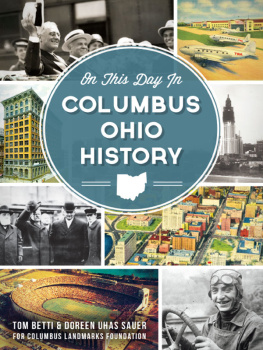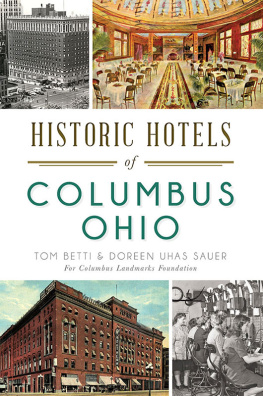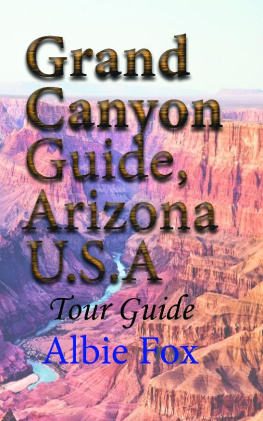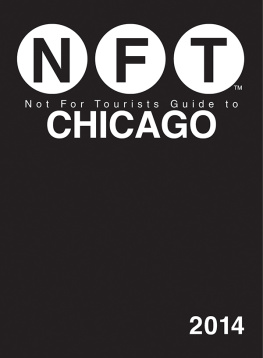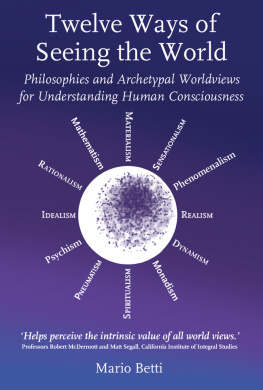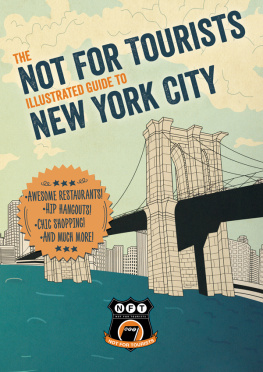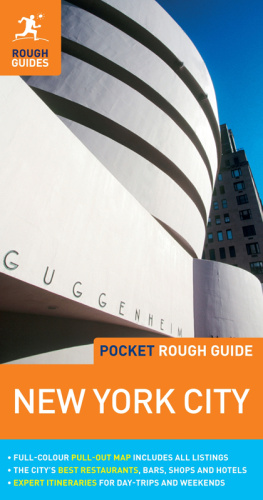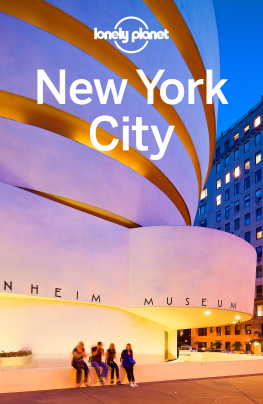Published by The History Press
Charleston, SC 29403
www.historypress.net
Copyright 2013 by Tom Betti, Ed Lentz and Doreen Uhas Sauer
All rights reserved
All images appear courtesy of Tom Betti, Columbus Metropolitan Library Collection, Franklinton Historical Society and Doreen Uhas-Sauer.
First published 2013
e-book edition 2013
ISBN 978.1.62584.656.3
Library of Congress CIP data applied for.
print edition ISBN 978.1.60949.669.2
Notice: The information in this book is true and complete to the best of our knowledge. It is offered without guarantee on the part of the author or The History Press. The author and The History Press disclaim all liability in connection with the use of this book.
All rights reserved. No part of this book may be reproduced or transmitted in any form whatsoever without prior written permission from the publisher except in the case of brief quotations embodied in critical articles and reviews.
The concept of a community-written encyclopedia was encouraged, funded and supported by the United Partnership Grant of the Columbus Foundation and the United Way of Central Ohio, along with their partnerships with the Bob Evans Restaurants, PNC Banks and the Osteopathic Heritage Foundation. In addition, support came from Chris Zacher and the Humanities House at the Ohio State University. Thank you.
More than any other project of Columbuss bicentennial year celebration in 2012, the award-winning WOSU Neighborhood Series video series of six neighborhoods created an awakening in each community to learn more about their history. To be featured in an hour-long documentary and work with the expertise and professionalism of the WOSU staff allowed each neighborhood to see that its historic roots and its living stories educated young people, attracted others to explore their streets and honored the neighborhood elders. Thank you.
The staff members of the Columbus Metropolitan Library have expertise, wit, humor and patience for the many workshops on their resources, inquiries (one more timeWhere can I find.?) and ability to find an obscure clipping in an antiquated but lovely old card catalog, thereby proving there is still much to be found on paper as online. Thank you.
INTRODUCTION
When is a building, a stone, a balcony, a brick, a sign, a wall, a park, an empty lot, an artifact or a phosphate soda a landmark?
In December 1964, Miss Fern Zetty, the descendant of a founding family (Vogl) in Franklinton, the first neighborhood of Columbus, was trying to convince others, mostly the city parks commission, that the first brick home in old Franklinton was worth saving as a historical landmark. The Sisters of Good Shepherd, who had resided in the home for over one hundred years, had already accepted $195,000 in damages when the new Sandusky Expressway took off a strip of their property, and they had also been awarded $535,000 from a federal grant to build a new hospital and convent in Mifflin Township to continue their work with troubled girls.
Miss Zetty knew that many supported the concept of retaining the old mansion as the center of a park. Several park commissioners found her ideas excellent in principle but expressed reservations about how much this would cost the city. The Franklin County Historical Society did not have the money to purchase the building.
Already there was the nagging little problem of the Alfred Kelly mansion on East Broad Street, an 1840s Greek Revival home and a landmark for both its architectural merit and its significance in Ohio history. Despite efforts to save that landmark by Dixie Sayre Miller, who took the issue to the state of Ohio, the disassembled stones were lying among weeds in Wolfe Park, and the donor money to rebuild was insufficient. The governor, with an eye to the budget, rejected the idea that the state should spend money to save Ohio history.
Eventually, the stones were numbered and sent to the Hale Farm in northern Ohio to be kept in anticipation of reconstruction. Never reassembled, the stones were finally released from their state of purgatory by Ms. Miller before her death, and the stones no longer are there. The Hale Farm was free to sell or dispense them as they saw fit.
The Sullivant home was torn down. The iron balcony that a Sullivant son had hung so proudly from the front of the house was saved and placed in the showroom of the Graham Ford dealership nearby. The dealership has been closed for a number of years, and the balcony remains inside.
A plaque marks the Sullivant mansions site, but as Miss Zetty said in a newspaper article, Once you tear down a place such as the Sullivant home, its gone. They put up a plaque. But what is a plaque? Nobody stops to read it. And indeed, the plaque is perched over the busy highway below and close to the busier West Broad Street traffic on a prairie of concrete.
From 1928 to 1936, the Centenary Methodist Episcopal church (established 1900) had the largest African American congregation on the near east side at the time, and they struggled in the midst of the Great Migration and the Great Depression to find money to finish their building on East Long and Eighteenth Streets and also to feed people in the neighborhood. Their priority was the need of the community. The partially constructed roof was put under temporary cover with no idea as to when or how the church would be finished. The congregation continued to meet in the basement. Rain or snow did not stop them.
Their grand vision eventually completed, the massive brick church with a five-story Gothic style bell tower reigned over East Long Street for six decades. It came down in 2011, despite neighborhood attempts to save it.
This is a book not about lost landmarks or the lack of money to preserve thembecause Columbus has been able to preserve, restore and reuse many historic structures and neighborhoods. It is the result of a discussion with neighborhood people about the concept of a landmark.
What is a landmark? Is a landmark always a monumental building or a historic structure?
The compiled writings of a community of authors and researchers indeed do confirm that landmarks are the churches, the parks and the historic houses, but, just as importantly, they are the places shaped by geography and by memory.
The WOSU Neighborhood Series presented an opportunity to consider a landmark in a much broader definitionisnt a landmark literally a marker in the landscape? Does it have to be old? Does it live as long as the memory of it lives? Landmarks can be fine old Victorian homes, but are they also ice cream stands that have served four generations?


